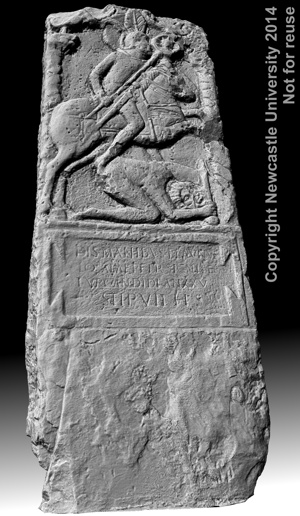
Our third blog entry on the 3D scans of Roman monuments associated with Hadrian’s Wall, products of our recent collaboration with University of Newcastle as part the NU Digital Heritage project (http://www.nu-digitalheritage.com). One of the planned uses of these digital models will be for use as a teaching resource for initiatives such as their free online Massive Online Open Course Hadrian’s Wall: Life on the Roman Frontier. Follow the links to see part one and part two of our blog series.
As it is pancake day we have chosen to show our scan of the Flavinus tombstone, which depicts a barbarian getting battered and flattened! Interestingly the Romans were big fans of pancakes. A Roman cookbook of the late 4th or early 5th century AD included a recipe for Ova spongia ex lacte (Pancakes with milk) and this dish was served with honey and black pepper.
As for the poor battered barbarian he appears on the bottom of the tombstone under the hooves of Flavinus a cavalryman of the ala Petriana. This tombstone was discovered built into the porch of the south transept of Hexham Abbey in 1881, but is believed to have come originally from the Roman Fort at Corbridge, Northumberland. The tombstone was placed on display inside the abbey and is still there to this day.
Flavinus was the standard-bearer of the ala Petriana, and his tombstone follows a typical cavalry memorial formula. The deceased is depicted, upon his horse, riding down a crouched barbarian clutching a club in a relief above the inscription. He wears a cavalryman's helmet and a torc around his neck. He also holds a shield and his standard, in his role as the standard-bearer, upon which a depiction of the sun-god, or an emperor imitating him, is clearly visible. An eagle is shown perched on the top of the standard. The details about Flavinus’ service indicate that he joined the army aged 18, which was the average age of recruits. The ala Petriana was a quingenary unit (i.e had around 480 men) when stationed at Corbridge.
For more information see:
Flavinus inscription on the Roman Inscriptions of Britain website
Corbridge Roman Fort (Coria)